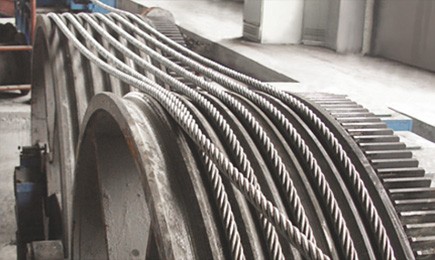First of all, the first point is that the fatigue cracks of the steel wire rope spread out from the source point in the form of a series of concentric rings. If the wire drawn on the fatigue wire is low, the area affected by fatigue is very large before the wire fails.
Secondly, the second point is that the fatigue origin of the steel wire rope and the small, severely worn fatigue crack with fatigue fracture lines that expand in a concentric manner clearly shows a fatigue crack.
The third point is two adjacent fatigue cracks. If the steel wire is subjected to local bending and extrusion, this kind of steel wire failure phenomenon will often see bending fatigue and broken wire. The steel wire has fatigue in the torsion and bending test, and cracks begin to appear in various situations.
Fourth, fatigue occurs under the influence of crack pressure, and the surface shows secondary deformation caused by the pressure.
Fifth, the wire breaks due to bending fatigue on the steel wire rope made of compacted outer strands. The distribution of bending fatigue broken wires is generally random.
Sixth, the severely worn wire rope with some fatigue broken wires. Due to the twisting of the wire rope, the ends of the broken wires shift to different directions.
Seventh, the wire rope showed basically no wear and tear, but there were a lot of fatigue and broken wires.
Eighth point, three adjacent strands have fatigue broken wires, and surface corrosion often triggers the formation of fatigue cracks.
Finally, the ninth point is that pitting and rust are associated with fatigue cracks. Bending fatigue breaks, and fatigue cracks begin to appear at the point where it contacts the crown wheel. The crack obviously expands concentrically to its starting point, and the crack becomes obvious only after the wire rope strand undergoes a tensile failure test.


 Jiangsu Taili Steel Rope Co., Ltd. covers an area of 5,000 square meters. It mainly produces high-quality steel wires and wire ropes of various specifications, with an annual production capacity of 30,000 tons and annual sales of 200 million yuan...
Jiangsu Taili Steel Rope Co., Ltd. covers an area of 5,000 square meters. It mainly produces high-quality steel wires and wire ropes of various specifications, with an annual production capacity of 30,000 tons and annual sales of 200 million yuan... Jiangsu Taili Steel Rope Co., Ltd. specializes in the production of high-quality steel wire ropes and steel wire rope products, and is committed to providing customers with a variety of high-quality steel wire and steel wire rope products...
Jiangsu Taili Steel Rope Co., Ltd. specializes in the production of high-quality steel wire ropes and steel wire rope products, and is committed to providing customers with a variety of high-quality steel wire and steel wire rope products... Pay attention to the real-time news or news released by Jiangsu Taili Steel Rope, and provide you with first-hand information about us!
Pay attention to the real-time news or news released by Jiangsu Taili Steel Rope, and provide you with first-hand information about us! The company's products have passed the ISO9001 quality system certification, and passed the ISO14001 environmental management system certification in 2008, to obtain better profits for customers in satisfactory use
The company's products have passed the ISO9001 quality system certification, and passed the ISO14001 environmental management system certification in 2008, to obtain better profits for customers in satisfactory use Taili always puts high-quality service in the same important position as the product, and uses a professional and high-standard service system to let customers feel the greatest heart and sincerity of Taili Steel Rope throughout the process, so as to achi
Taili always puts high-quality service in the same important position as the product, and uses a professional and high-standard service system to let customers feel the greatest heart and sincerity of Taili Steel Rope throughout the process, so as to achi Thank you for your attention to Taili. If you have any cooperation needs about products or services, please contact us in time; After receiving your consultation information, Taili’s service consultants will understand your needs in detail within 24 hours
Thank you for your attention to Taili. If you have any cooperation needs about products or services, please contact us in time; After receiving your consultation information, Taili’s service consultants will understand your needs in detail within 24 hours